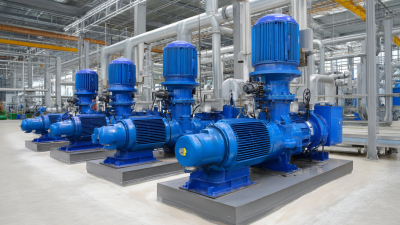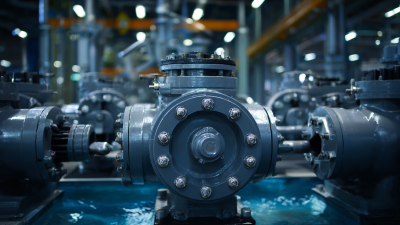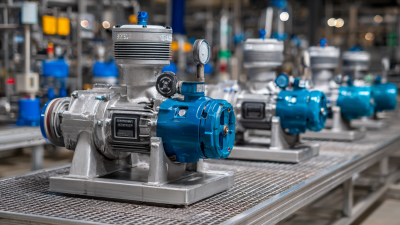Contact Us
Unlocking the Power: How High Pressure Pumps for Water Revolutionize Industrial Applications
The industrial landscape has witnessed transformative advancements in recent years, with high pressure pump for water emerging as a pivotal technology driving efficiency and productivity. According to a 2022 report by Industry Research, the global high-pressure pump market is projected to reach approximately $5 billion by 2027, growing at a CAGR of 5.6%. These pumps are instrumental across various sectors, including manufacturing, food processing, and oil and gas, where they facilitate crucial processes such as water jet cutting, cleaning, and chemical injection.

The ability of high pressure pumps to deliver water at extreme pressures enables industries to optimize their operations, reduce waste, and enhance overall output quality. As the demand for sustainable and efficient water management solutions continues to escalate, the role of high pressure pumps in industrial applications is set to become even more significant, unlocking new potentials for innovation and growth.
Understanding High Pressure Pump Technology and Its Components
High pressure pump technology plays a critical role in various industrial applications, offering enhanced efficiency and performance. These pumps typically operate at pressures exceeding 1000 psi, and their components, including pistons, valves, and seals, are designed to withstand extreme conditions. According to a report by MarketsandMarkets, the global high pressure pump market is projected to grow from USD 8 billion in 2020 to USD 11 billion by 2025, reflecting a compound annual growth rate (CAGR) of 7.4%. This growth is largely driven by the increasing demand for high efficiency in sectors such as oil and gas, chemical processing, and water treatment.
Understanding the core components of high pressure pumps is essential for optimizing their performance. The heart of these pumps is often a reciprocating mechanism that converts rotational energy into linear motion, creating high pressure through a combination of fluid dynamics and mechanical engineering. Advanced materials like ceramic and hardened steel are commonly used in the construction of pump components to provide durability and resistance to abrasive fluids. Industry efforts are also focusing on improving the energy efficiency of these systems, with some manufacturers reporting reductions in energy consumption by up to 30% through innovative designs and technologies.
Unlocking the Power: How High Pressure Pumps for Water Revolutionize Industrial Applications
| Pump Type | Maximum Pressure (bar) | Flow Rate (L/min) | Efficiency (%) | Application Areas |
|---|---|---|---|---|
| Diaphragm Pump | 10-100 | 5-50 | 85 | Chemical Processing, Water Treatment |
| Plunger Pump | 50-200 | 10-200 | 90 | Oil & Gas, Hydrostatic Testing |
| Centrifugal Pump | 5-70 | 20-600 | 75 | Water Supply, Irrigation |
| Gear Pump | 15-150 | 5-100 | 80 | Hydraulic Systems, Fuel Handling |
| Screw Pump | 20-120 | 30-300 | 88 | Chemical Injection, Wastewater Management |
Selecting the Right High Pressure Pump for Industrial Applications
When selecting the right high pressure pump for industrial applications, it is crucial to consider factors like pressure requirements, flow rate, and the type of fluid being handled. According to a report by the International Pump Manufacturers Association (IPMA), the demand for high pressure pumps in various industrial sectors has grown by approximately 15% over the past five years, driven largely by advancements in technology and increased efficiency needs. Industries such as oil and gas, chemical processing, and water treatment are increasingly relying on these pumps to optimize their operations.

Furthermore, understanding the specific requirements of each application is vital. For instance, a high pressure pump used in hydraulic fracturing must withstand extreme pressures up to 15,000 PSI, while pumps used in water jet cutting typically operate around 40,000 PSI. The right selection can lead to enhanced system performance, reduced downtime, and prolonged equipment life. The latest market analysis indicates that improper pump selection can result in inefficiencies costing industries nearly $1 million per year, emphasizing the importance of making informed choices when equipping facilities with high pressure pumping solutions.
Maintaining High Pressure Pumps for Optimal Performance and Longevity
High pressure pumps play a crucial role in various industrial applications, and maintaining them is essential for optimal performance and longevity. According to a report by Research and Markets, the global high pressure pump market is expected to reach approximately $6 billion by 2026, indicating a significant demand for these reliable systems. Regular maintenance practices can extend the lifespan of these pumps and ensure they operate at peak efficiency, which is crucial in sectors such as oil and gas, water treatment, and manufacturing.
One key aspect of maintenance involves monitoring the pump’s critical components, such as seals, bearings, and impellers. Data from the Hydraulic Institute shows that properly maintained pumps can save up to 20% in energy costs, which translates to considerable savings for businesses over time. Additionally, implementing condition monitoring tools can help detect potential failures before they escalate, thereby minimizing downtime and costly repairs. By investing in a proactive maintenance strategy, industries can harness the full potential of high pressure pumps and contribute to their operational excellence.
Integrating High Pressure Pumps into Existing Water Systems
Integrating high pressure pumps into existing water systems can significantly enhance efficiency and optimize performance in various industrial applications. These pumps are designed to deliver water at elevated pressures, making them ideal for processes such as cleaning, cooling, and transporting fluids. By seamlessly fitting high pressure pumps into pre-existing systems, industries can upgrade their capabilities without the need for extensive infrastructural changes.

Tips for successful integration include evaluating the compatibility of the pump with current water system components. Ensure that the pipes, valves, and fittings can handle the increased pressure to avoid leaks or failures. Additionally, consider implementing smart control systems that can monitor and adjust pump performance based on real-time data, leading to energy savings and extended equipment life.
Moreover, regular maintenance is crucial to ensure the reliability of high pressure pumps. Schedule routine check-ups and be proactive in replacing worn-out seals and gaskets to prevent breakdowns. Training personnel on proper operational procedures will further enhance the longevity and efficiency of the integrated systems, maximizing the benefits of transitioning to high pressure pumps.
Exploring Innovative Applications of High Pressure Pumps in Various Industries
High pressure pumps play a crucial role in various innovative applications across multiple industries, particularly in the field of water supply and treatment. For instance, the advancement in desalination techniques has garnered attention recently. According to industry reports, the global desalination market is projected to reach a value of $35 billion by 2024, with high pressure pumps being central to this technology. These pumps facilitate the reverse osmosis process, where seawater is processed to extract freshwater, making it a vital resource in arid regions.
Moreover, high pressure pumps are instrumental in industrial cleaning and maintenance tasks. Data from leading market research indicates that the industrial cleaning market could exceed $60 billion globally, with high pressure cleaning systems enhancing efficiency and reducing water usage by up to 80% compared to traditional methods. This not only conserves water but also minimizes the environmental impact, aligning with global sustainability goals. The continuous innovation of pumping technologies underscores their significance in modern industrial applications, driving efficiencies and fostering a sustainable future.
Unlocking the Power: High Pressure Pumps in Industrial Applications
This chart illustrates the innovative applications of high pressure pumps across various industries, showcasing their impact and efficiency.
Related Posts
-

Maximizing Efficiency: The Ultimate Guide to Choosing the Right Vertical Centrifugal Pump for Your Needs
-

Understanding the Mechanisms and Applications of High Head Pumps in Modern Industry
-

The Essential Guide to Choosing the Right Boiler Condensate Pump for Your Home
-

Maximizing Efficiency: The Role of Boiler Condensate Pumps in Energy Savings and System Performance
-

The Future of Industrial Centrifugal Pumps Innovations and Trends You Need to Know
-

Understanding the Efficiency of High Pressure Centrifugal Pumps in Industrial Applications
